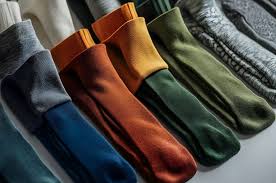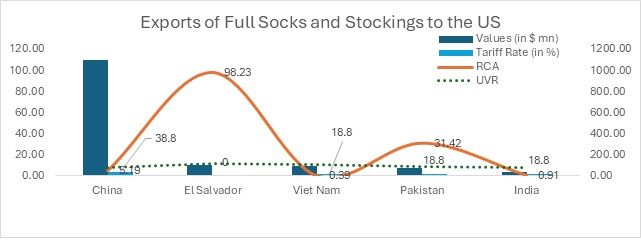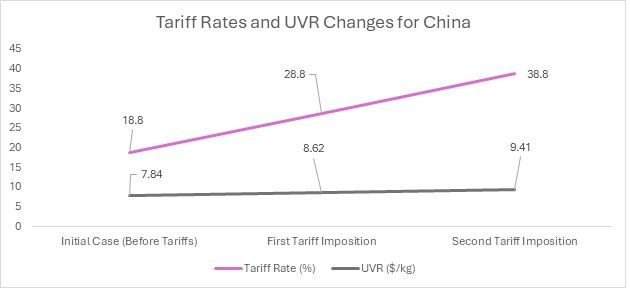Tariffs to reshape US stockings and socks imports: New winners emerge

TARIFFS TO RESHAPE US STOCKINGS AND SOCKS IMPORTS: NEW WINNERS EMERGE
Hosiery, full-length stockings, and socks are essential items in the US apparel market, combining both functional and aesthetic qualities. With demand driven by seasonal fashion trends and year-round utility, these products have established a steady presence in the US market. Leading exporters include China, El Salvador, Vietnam, Pakistan, and India, each of which plays a significant role in fulfilling US consumer demand. However, as trade dynamics evolve—particularly with the imposition of tariffs on China—the competitive landscape for hosiery, full-length stockings, and socks could undergo significant changes. Understanding these trends is vital for anticipating future shifts in market opportunities.
Table 1: Key exporting countries and trade statistics – hosiery full-length stockings and socks to the US in CY 2024

Source: TradeMap and F2F Analysis *Effective March 4, 2025
Notes: RCA (Revealed Comparative Advantage), UVR (Unit Value Realisation), LPI (Logistic Performance Index
Figure 1: Key exporting countries and trade statistics – hosiery, full-fength stockings and socks to the US in CY 2024

Source: TradeMap and F2F Analysis
Trade Review: Shifting competitive dynamics in the US’ hosiery, full-length stockings and socks market
China: Market leader facing tariff pressures
China continues to dominate US imports of hosiery, full-length stockings, and socks, with an export value of $1,095.28 million. Its RCA of 5.19 highlights a strong competitive position, supported by a low UVR of $7.84/kg, making it the top supplier for budget-conscious buyers.
However, China faces mounting challenges due to increased tariffs, which are gradually eroding its price advantage:
- Before tariff hikes: An 18.8 per cent tariff kept China’s UVR at an attractive $7.84/kg, allowing it to dominate the market.
- First Tariff Imposition (February 4, 2025): The tariff increased to 28.8 per cent, pushing China’s UVR to approximately $8.62/kg, reducing its appeal to price-sensitive consumers.
- Second Tariff Imposition (March 4, 2025): The tariff rose further to 38.8 per cent, raising China’s UVR to an estimated $9.41/kg or higher.
Figure 2

Source: F2F Analysis
Despite the rising cost burden, China is unlikely to be fully displaced, as its superior logistics, economies of scale, and production efficiency continue to provide a competitive edge. However, the loss of its cost leadership could open opportunities for emerging competitors—particularly India and Pakistan—which are well positioned to absorb some of the displaced demand.
El Salvador: Niche player with a strong competitive edge
El Salvador, though a smaller exporter ($107.99 million), boasts a remarkably high RCA of 98.23, indicating an exceptional specialisation in the production of hosiery, stockings, and socks. It benefits from:
- Zero tariff rates under the CAFTA-DR trade agreement, ensuring cost competitiveness.
- A focus on high-quality and specialised products, setting it apart from mass-market suppliers like China.
A key challenge for El Salvador is its relatively low LPI of 2.70, which may limit its ability to scale up exports and meet increased demand resulting from China’s tariff-related setbacks. However, its proximity to the US and favourable trade agreements are likely to support the sustainability and gradual expansion of its market share over time.
Vietnam: Balancing quality with cost constraints
Vietnam ranks third in exports, with $91.12 million, but its RCA of 0.39 suggests a weaker competitive position in this segment. Unlike China, Vietnam operates in a higher price bracket, reflected in its UVR of $11.04/kg, catering to premium buyers rather than cost-sensitive consumers.
Vietnam faces the same 18.8 per cent tariff, making it less competitive on price. While its focus on higher-quality, value-added products offers a niche advantage, rising tariffs may limit its ability to expand further in the US market.
Pakistan: Emerging cost-leader with strong market potential
Pakistan, with $78.37 million in exports, holds a high RCA of 31.42, indicating a significant competitive strength in this category. It also offers a moderate UVR of $8.56/kg, positioning it between China’s low-cost offerings and Vietnam’s premium products.
While Pakistan also faces an 18.8 per cent tariff, its relatively lower production costs ensure it remains a viable and cost-effective alternative to China. Given China’s rising costs, Pakistan is well positioned to capture a portion of China’s lost market share—particularly in the budget-friendly segment.
India: A Potential Beneficiary of China’s Tariff Burden
India ranks fifth, with $37.79 million in exports, and holds a modest RCA of 0.91, indicating limited specialisation in this category. However, its UVR of $8.19/kg is lower than Pakistan’s and close to China’s pre-tariff levels, making it a cost-effective alternative.
While India also faces an 18.8 per cent tariff, its lower production costs and growing focus on the US market could enable it to gain market share. If demand continues to shift away from China, India may be well positioned to scale up production and capture a larger portion of the cost-sensitive segment.
Outlook: Market shifts and emerging winners
The US hosiery, full-length stockings, and socks market is undergoing significant shifts due to rising tariffs on China, which are altering cost structures and trade patterns.
Key trends moving forward:
- China will retain a strong market share but lose its cost leadership, prompting demand to shift towards lower-cost suppliers such as Pakistan and India.
- El Salvador will strengthen its niche position, benefitting from zero tariffs and a focus on high-quality, specialised products.
- Pakistan is poised to gain the most from China’s tariff increases, offering cost-effective exports that position it as a natural alternative.
- India may see rising demand as it reallocates production and expands its presence in the US market.
- Vietnam will continue to serve premium buyers, but tariff pressures may constrain its growth.
Conclusion
As tariffs reshape the market landscape, Pakistan and India emerge as strong contenders, while El Salvador capitalises on its duty-free access. China is expected to maintain a dominant share but must navigate the challenge of sustaining competitiveness amid rising tariffs. The US hosiery, stockings, and socks market is poised for a major realignment, with lower-cost and trade-friendly nations positioned to benefit the most.
By Fibre2Fashion
https://www.fibre2fashion.com/news/clothing-news/tariffs-to-reshape-us-stockings-and-socks-imports-new-winners-emerge-301540-newsdetails.htm
